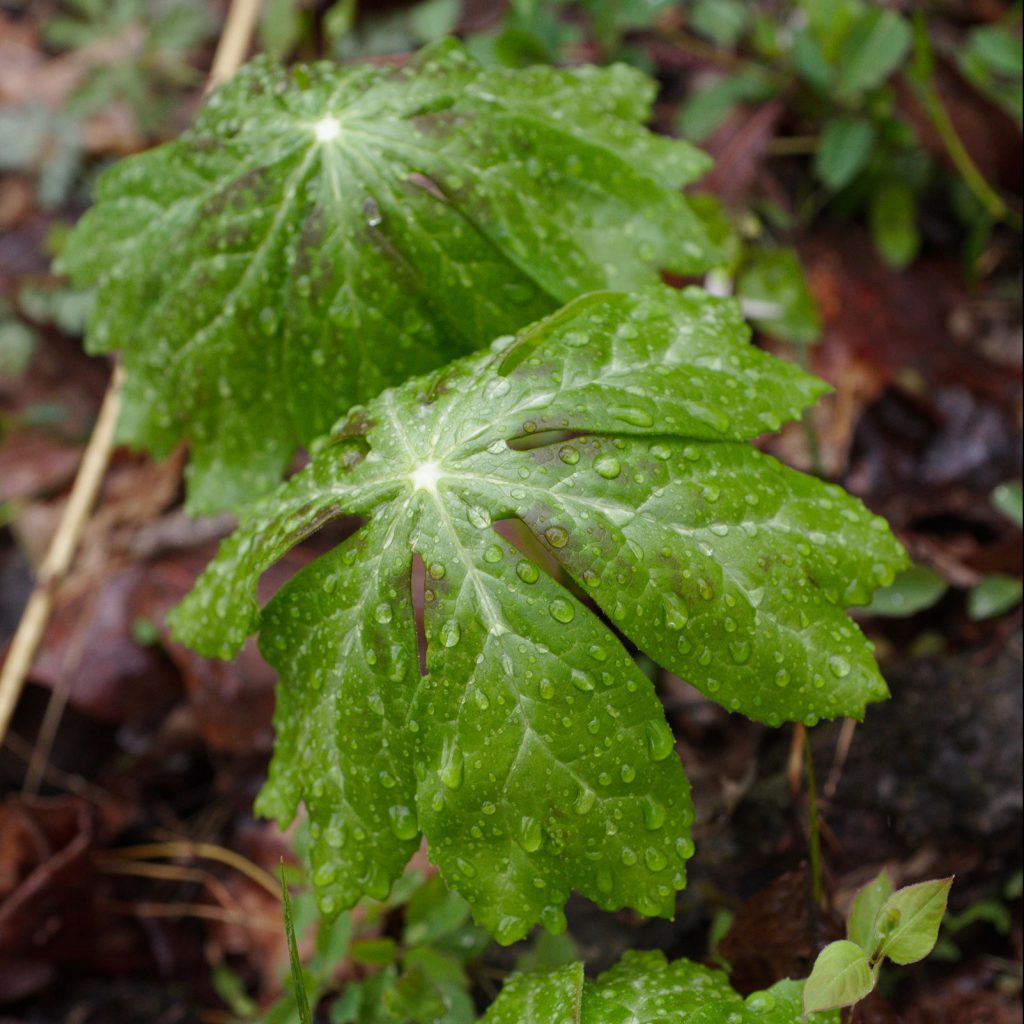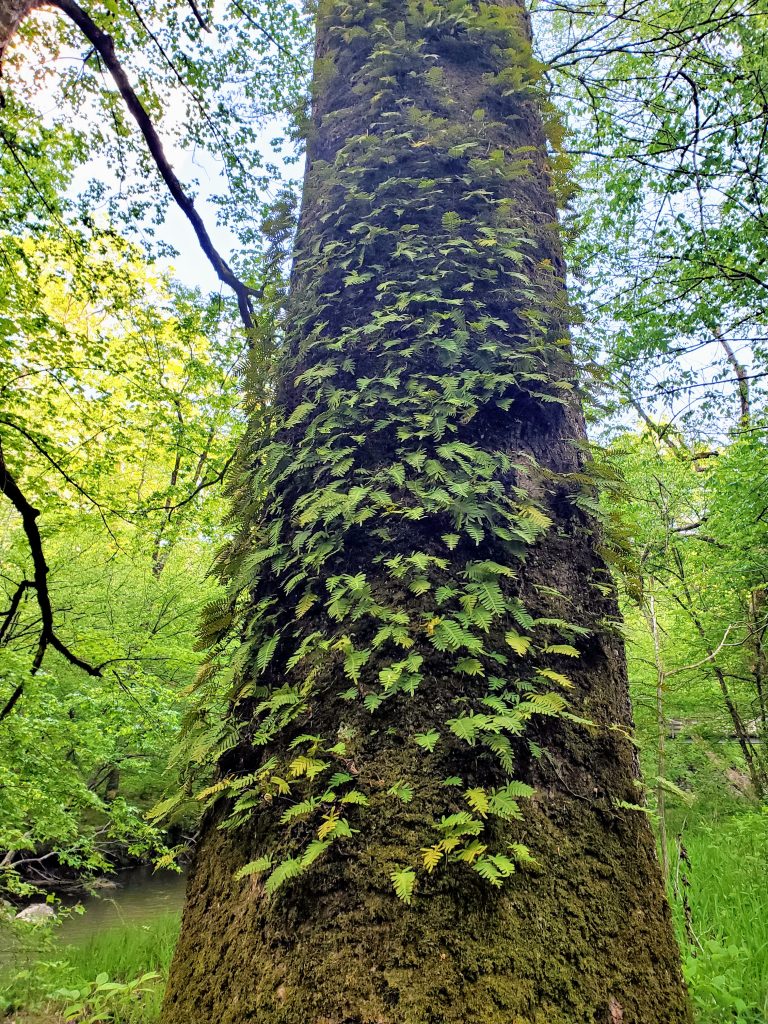by Katherine Hale
The trails around New Hope Creek in the Korstian Division have always been the most popular in Duke Forest, and with good reason. Not only are they conveniently located between Durham and Chapel Hill, the New Hope Creek region is a state-ranked Natural Heritage Natural Area on account of the amazing biodiversity it harbors, including many species rarely found in the Triangle—or in some cases, the world.
Since the statewide shutdown in mid-March, trail usage in the Korstian Division has soared as people look for opportunities for fresh air, exercise, and of course, the beauty and solace of the natural world during this uncertain time. Though we ask all visitors to obey the rules and remain on the trails at all times to protect these special plant communities—especially in this time of heightened use—there’s no shortage of wonders to be found. Here are six common—yet extraordinary—sights to brighten your day that you can easily spy without stepping off the beaten path.
Flowering Dogwood

The flowering dogwood (Cornus florida) is our most recognizable native tree, easily spotted from a distance when in bloom. What look like white “petals” from a distance are really bracts, or modified leaves, with the true flowers being tiny, green, and clustered around the center, where the brilliant red berries appear in the fall. Dogwoods favor sunny edges and the woodland understory, and are a popular landscape tree, with many cultivars available for purchase—including a few with bright pink bracts. So popular, in fact, that the species was dubbed the official state flower of North Carolina in 1941.
Because they are widespread throughout the southeast, the National Phenology Network uses dogwoods as an indicator species in their citizen science programs to track long-term patterns of climate change.
Coral Honeysuckle

Coral honeysuckle (Lonicera sempervirens) is another showy native species that doubles as a popular garden plant. The tubular bright red flowers are almost as popular with humans as they are with ruby-throated hummingbirds, who flock to this plant when in bloom. Unfortunately, this species is much less common in our region than the non-native Japanese honeysuckle (Lonicera japonica), which is sadly abundant in Duke Forest. The two climbing vines are easy to tell apart—Japanese honeysuckle has white or yellow flowers instead of red, and is deciduous, while coral honeysuckle blooms are crimson and evergreen. This makes it easy to spot coral honeysuckle in the winter, when most other plants have dropped their leaves.
Jack-in-the-Pulpit

Jack-in-the-pulpit (Arisaema triphyllum) is an odd duck—a three-pointed leaf on a long stalk next to a flower wrapped in a stripped black-and-green leaf known as a spathe (the “pulpit”). “Jack” is the nickname for the spike of tiny white flowers nestled inside. A closer look reveals that “Jack” is something of a misnomer—the first flowers that open are male, but they are soon replaced by female “Jills”. These strange plants are pollinated by tiny flies known as fungus gnats, who are attracted by scent to both male and female flowers. While the gnats can easily escape “Jack” flowers, they are trapped by the “Jills,” thus ensuing cross-pollination. Although less frequently seen in gardens, this species has many Asian relatives, known as cobra lilies, that are commonly grown.
Mayapple

The distinctive leaves of mayapple (Podophyllum peltatum) look like little umbrellas set out in moist, shady parts of the forest floor. Plants with one leaf will not flower this year, but plants with two leaves will have a single flower tucked away on the central stalk underneath. The tiny yellow fruits are a favorite food of box turtles, who spread the seeds as they move through the undergrowth. As box turtles decline across the Piedmont, will mayapples follow? This is all the more reason to protect existing populations.
Resurrection Fern

Like many orchids or the famed “Spanish moss” of the coastal plains, resurrection ferns (Pleopeltis polypodioides) are epiphytes, found only on the trunks of trees—never on the ground. Though each individual fern is tiny, they grow in large colonies along the shadier sides of oaks and other large trees along the steep bluffs of New Hope Creek, pulling nutrients and moisture out of the air. These ferns love humidity and water evaporating off the creek, but drought or cold dry spells during the winter present a challenge for their survival. To survive, the ferns make special proteins known as dehydrins that compress their cell walls, allowing them to lose ninety percent of their water and go into suspended animation. When the rain returns, the cell walls snap back into position, trapping the water in place and the plant returns to life.
Catawba Rhododendron

Catawba Rhododendron (Rhododendron catawbiense) is abundant throughout the southern Appalachians, but is uncommon in the North Carolina piedmont. You’ll find it growing along the cool, shady banks of New Hope Creek, especially on north-facing bluffs. Because these slopes are so steep, erosion is a major concern for maintaining the health of these plants. In 2013, Duke Forest staff re-routed and improved the trails to reduce the impact of foot traffic around rhododendron habitat. While the population has suffered due to habitat degradation and disease, we hope that this restoration effort helps keep the lovely pink blooms around for as long as possible.
Access to nature is essential for human health and well-being, particularly with so many alternatives currently closed or unavailable. We welcome visitors to walk, or jog the trails in the Korstian Division and observe these six standouts as well as the hundreds of other species that call the Duke Forest home. Take care of each other by staying six feet away from other visitors—and take care of Duke Forest by taking your trash with you and staying on trails. Enjoy your visit, and happy botanizing!





